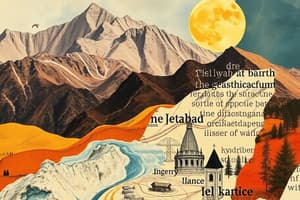Podcast
Questions and Answers
Which of the following are major climate zones?
Which of the following are major climate zones?
- Desert (correct)
- Arctic
- Tropical (correct)
- Subtropical
What is the process called that involves the accumulation of eroded materials?
What is the process called that involves the accumulation of eroded materials?
- Deposition (correct)
- Erosion
- Weathering
- Sedimentation
Which of the following correctly describes soil composition?
Which of the following correctly describes soil composition?
- Granite, limestone, and basalt
- Clay, silt, sand, and loam (correct)
- Chalk, peat, and clay
- Water, minerals, and organic matter
What natural hazard is most commonly triggered by heavy rainfall?
What natural hazard is most commonly triggered by heavy rainfall?
Which tool is primarily used for mapping and analyzing spatial data?
Which tool is primarily used for mapping and analyzing spatial data?
Which factor is NOT typically associated with soil formation processes?
Which factor is NOT typically associated with soil formation processes?
Which process involves the breakdown of rocks through various means?
Which process involves the breakdown of rocks through various means?
What type of biome is characterized by little rainfall, extreme temperatures, and sparse vegetation?
What type of biome is characterized by little rainfall, extreme temperatures, and sparse vegetation?
Flashcards are hidden until you start studying
Study Notes
Physical Geography
-
Definition: The branch of geography that deals with the natural environment and the physical processes that shape the Earth's surface.
-
Key Components:
- Landforms:
- Mountains, hills, plateaus, plains, valleys, and deserts.
- Formed through tectonic activity, erosion, and sedimentation.
- Climate:
- Long-term weather patterns of a region, influenced by latitude, altitude, and proximity to water bodies.
- Major climate zones: tropical, arid, temperate, polar, and highland.
- Soils:
- Composition and types of soil, including clay, silt, sand, and loam.
- Soil formation processes: weathering, organic material accumulation, and erosion.
- Water Bodies:
- Rivers, lakes, oceans, and groundwater.
- Role in shaping landscapes and supporting ecosystems.
- Ecosystems:
- Interaction of living organisms with their physical environment.
- Major biomes: tundra, rainforest, savanna, desert, and temperate forest.
- Landforms:
-
Natural Hazards:
- Earthquakes: Caused by tectonic plate movements.
- Volcanic eruptions: Result from magma escaping to the surface.
- Floods: Often caused by heavy rainfall, snowmelt, or dam failures.
- Landslides: Triggered by heavy rain, earthquakes, or human activity.
-
Processes:
- Weathering: Breakdown of rocks through physical, chemical, or biological means.
- Erosion: Removal and transport of soil and rock by wind, water, or ice.
- Deposition: Accumulation of eroded materials in new locations.
-
Human Impact:
- Deforestation, urbanization, and agriculture altering natural landscapes.
- Climate change effects on weather patterns, sea levels, and biodiversity.
-
Tools and Techniques:
- Geographic Information Systems (GIS): For mapping and analyzing spatial data.
- Remote sensing: Using satellite imagery to study physical features and changes over time.
-
Importance:
- Understanding physical geography is crucial for environmental management, disaster preparedness, and sustainable development.
Physical Geography Overview
- Focuses on natural environments and processes shaping Earth’s surface.
Key Components
-
Landforms:
- Types: mountains, hills, plateaus, plains, valleys, deserts.
- Formed through processes like tectonic activity, erosion, and sedimentation.
-
Climate:
- Defined as long-term weather patterns influenced by latitude, altitude, and proximity to water.
- Major climate zones include tropical, arid, temperate, polar, and highland.
-
Soils:
- Composed of clay, silt, sand, and loam.
- Formation processes involve weathering, organic material buildup, and erosion.
-
Water Bodies:
- Includes rivers, lakes, oceans, and groundwater.
- Essential for landscape shaping and supporting ecosystems.
-
Ecosystems:
- Represents interactions between organisms and their physical environment.
- Major biomes include tundra, rainforest, savanna, desert, and temperate forest.
-
Natural Hazards:
- Earthquakes arise from tectonic plate movements.
- Volcanic eruptions occur when magma escapes to the surface.
- Floods can be triggered by heavy rainfall, snowmelt, or dam failures.
- Landslides often result from excessive rainfall, seismic activity, or human impact.
Processes
-
Weathering:
- Involves the breakdown of rocks through physical, chemical, or biological means.
-
Erosion:
- The process of removing and transporting soil and rock, facilitated by wind, water, or ice.
-
Deposition:
- Accumulation of eroded materials in new locations leading to landform changes.
Human Impact
- Activities such as deforestation, urbanization, and agriculture significantly alter natural landscapes.
- Climate change affects weather patterns, rising sea levels, and biodiversity loss.
Tools and Techniques
-
Geographic Information Systems (GIS):
- Used for mapping and spatial data analysis.
-
Remote Sensing:
- Employs satellite imagery to study physical features and monitor changes over time.
Importance
- Knowledge of physical geography is essential for effective environmental management, disaster preparedness, and promoting sustainable development.
Studying That Suits You
Use AI to generate personalized quizzes and flashcards to suit your learning preferences.




